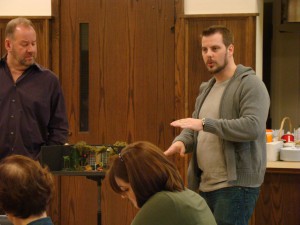
Scenic Designer Keith Pitts discusses the set
Hey there! My name is Brandon Pape and I am the assistant director for Writers’ Theatre’s upcoming production of George Bernard Shaw’s Heartbreak House. Rehearsals have begun and I will tell you about how it is going in my next post. Today, I want to talk about the design for the show and share a few thoughts that have come out of our production meetings. I’ll also let you in on a few of the choices we are pursuing to make this production of Heartbreak House unlike any other.
The first production meeting is an exhilarating part of any play process, but it is especially so when working on a revival. This is where the team first gets to hear what the director has planned for this particular incarnation of the script and to discuss what each designer is drawn to about the story, the characters, the setting, etc. The question is always: Why do this play? Why now? Why here? Bill Brown, the director, began by asking the team which character in the story they identified with. Is it young, idealistic Ellie? Or is it dashing and suave Hector? Or maybe it’s Captain Shotover, with his sharp, often hilarious one-liners. By the time everyone had shared their answer, it became clear that – although this play was written almost 100 years ago – the characters and subject matter are thrillingly identifiable and relevant today. It also served as a great ice-breaker, giving us some keen insight into the psyche of each member of our production team, and the opportunity to poke fun at people’s answers. (Kidding…)
Bill then made a compelling campaign for the piece. He was quick to point out that most people’s perception of Shaw as being “too talky” is the result of seeing productions that miss out on the emotional and intellectual playground that exists within many of his scripts (it helps that this is Bill’s favorite Shaw play). “Every play ends up being Shaw,” he declared early on. “Every play is about talk.” He also mentioned the ties in tonality between this play and the writing of Chekhov (the overwhelming loneliness of the characters, the idyllic but isolated family estate setting, the idea of clinging to a lost or dying way of life). He highlighted how this play comes alive very differently in performance than it does on the page, and that the key to portraying these characters is to always respect them and invest in their humanity. It’s also very, very funny.
One choice that Bill introduced early on is his desire to move the play’s setting from the eve of WWI to 1940, just before the Blitz, so that the looming danger – and the threat of “the end of a civilization” – is able to loom larger and more violently over the character’s heads (“The idea of balloons dropping seems quaint,” Bill observed). He also suggested a radical way to accommodate the play’s scenic demands (it takes place in two different locations on a countryside estate) that is sure to provide a fun environment – that playground of the mind – for actors and audience alike to make new and fresh discoveries about the story.
I won’t reveal any more than that…for now. All I can say is that things are shaping up to be beautiful, audacious, and loads of fun. This will certainly be Shaw unlike you’re used to seeing him, and I for one can’t wait to get acquainted with the characters that will populate this House.


No comments yet.